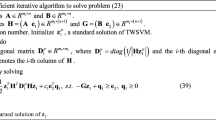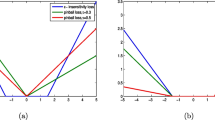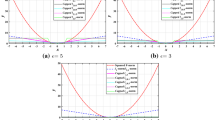Abstract
In this paper, we propose a new 0.00,0.00,1.00 fast robust twin extreme learning machine (FRTELM) based on the least squares sense and capped L1-norm distance metric. FRTELM first replaced the inequality constraints in TELM with equality constraints, and then introduced the capped L1-norm distance metric to replace the L2-norm distance metric in TELM. FRTELM not only retains the advantages of TELM, but also overcomes the shortcomings of TELM exaggeration of outliers based on squared L2-norm distance metrics. This improvement improves the robustness and learning efficiency of TELM in solving outlier problems. An efficient optimization algorithm is exploited to solve the nonconvex and nonsmooth challenging problem. In theory, we analyze and discuss the complexity of the algorithm in detail, and prove the convergence and local optimality of the algorithm. Extensive experiments conducted across multiple datasets demonstrates that the proposed method is competitive with state-of-the-art methods in terms of robustness and feasibility.



Similar content being viewed by others
References
Huang GB, Zhu QY, Siew CK (2006) Extreme learning machine: theory and applications. Neurocomputing 70(1-3):489–501
Huang GB, Zhou H, Ding X, Zhang R (2012) Extreme learning machine for regression and multiclass classification. IEEE Trans Syst Man Cybern B Cybern 42(2):513–529
Wang G, Zhao Y, Wang D (2008) A protein secondary structure prediction frame-work based on the extreme learning machine. Neurocomputing 72(1-3):262–268
Lan Y, Soh YC, Huang G-B (2008) Extreme Learning Machine based bacterial protein subcellular localization prediction. In: Proceedings of the IEEE international joint conference on neural networks. IJCNN 2008, Hong Kong, pp 1859–1863
Mohammed AA, Minhas R, Jonathan Wu QM, Sid-Ahmed MA (2011) Human face recognition based on multidimensional PCA and extreme learning machine. Pattern Recognit 44(10-11):2588–2597
Nizar AH, Dong ZY, Wang Y (2008) Power utility nontechnical loss analysis with extreme learning machine method. IEEE Trans Power Syst 23(3):946–955
Decherchi S, Gastaldo P, Dahiya RS, Valle M, Zunino R (2011) Tactile data classification of contact materials using computational intelligence. IEEE Trans Robot 27(3):635–639
Huang GB, Ding XJ, Zhou HM (2010) Optimization method based extreme learning machine for classification. Neurocomputing 74:155–163
Yang L, Zhang S (2017) A smooth extreme learning machine framework. J Intell Fuzzy Syst 33(6):3373–3381
Yang L, Zhang S (2016) A sparse extreme learning machine framework by continuous optimization algorithms and its application in pattern recognition. Eng Appl Artif Intell 53(C):176–189
Ma J, Wen Y, Yang L (2019) Lagrangian supervised and semi-supervised extreme learning machine. Appl Intell 49(2):303–318
Jayadeva, Khemchandani R, Chandra S (2007) Twin support vector machines for pattern classification. IEEE Trans Pattern Anal Mach Intell 29(5):905–910
Wan Y, Song S, Huang G, Li S (2017) Twin extreme learning machines for pattern classification. Neurocomputing 260:235–244
Lu X, Zou H, Zhou H, Xie L, Huang GB (2016) Robust extreme learning machine with its application to indoor positioning. IEEE Trans Cybern 46(1):194–205
Zhuo R, Liming Y (2018) Correntropy-based robust extreme learning machine for classification. Neurocomputing 313:74–84
Barreto GA, Barros ALBP (2016) A robust extreme learning machine for pattern classification with outliers. Neurocomputing 176:3–13
Lu XJ, Ming L, Liu WB, Li HX (2017) Probabilistic regularized extreme learning machine for robust modeling of noise data. IEEE Trans Cybern 48(8):1–10
Zhang K, Luo M (2015) Outlier-robust extreme learning machine for regression problems. Neurocomputing 151:1519–1527
Chen K, Lv Q, Lu Y, Dou Y (2017) Robust regularized extreme learning machine for regression using iteratively reweighted least squares. Neurocomputing 230:345–358
Gao S, Ye Q, Ye N (2011) L1-norm least squares twin support vector machines. Neurocomputing 74(17):3590–3597
Ye Q, Zhao H, Li Z, Yang X, Gao S, Yin T, et al. (2017) L1-norm distance minimization-based fast robust twin support vector k-plane clustering. IEEE Trans Neur Net Lear Sys 29(9):1–10
Meng D, Zhao Q, Xu Z (2012) Improve robustness of sparse PCA by L1,-norm maximization. Pattern Recognit 45(1):487–497
Wang H, Lu X, Hu Z, Zheng W (2014) Fisher discriminant analysis with L1,-norm. IEEE Trans Cybern 44(6):828–842
Jiang W, Nie F, Huang H (2015) Robust dictionary learning with capped l1-norm. In: International conference on artificial intelligence. AAAI Pres, pp 3590–3596
Nie F, Huo Z, Huang H (2017) Joint capped norms minimization for robust matrix recovery. In: Proceedings of the 26th international joint conference on artificial intelligence. AAAI Press, pp. 257–2563
Wu MJ, Liu JX, Gao YL, Kong XZ, Feng CM (2017) Feature selection and clustering via robust graph-laplacian PCA based on capped L1-norm. IEEE International Conference on Bioinformatics & Biomedicine. IEEE
Zhao M, Chow TWS, Zhang H, Yan L (2017) Rolling fault diagnosis via robust semi-supervised model with capped L2,1-norm regularization. In: IEEE international conference on industrial technology
Nie F, Huang H, Cai X, Ding C (2010) Efficient and robust feature selection via joint L2,1-norms minimization. In: International conference on neural information processing systems, pp 1813–1821
Xiang S, Nie F, Meng G, Pan C, Zhang C (2012) Discriminative least squares regression for multiclass classification and feature selection. IEEE Trans Neural Netw Learn Syst 23(11):1738–1754
Nie F, Wang X, Huang H (2017) Multiclass capped Lp-norm SVM for robust classifications. In: The 31st AAAI conference on artificial intelligence (AAAI), San Francisco, pp 2415–2421
Nie F, Huang Y, Wang X, Huang H (2014) New primal SVM solver with linear computational cost for big data classifications. In: International conference on machine learning, (II¨C505)
Wang C, Ye Qn, Luo P, Ye N, Liyong Fu (2019) Robust capped L1,-norm twin support vector machine. Neural Networks 114:47–59. https://doi.org/10.1016/j.neunet.2019.01.016
Fernández Pierna JA, Lecler B, Conzen JP, Niemoeller A, Baeten V, Dardenne P (2011) Comparison of various chemometric approaches for large near infrared spectroscopic data of feed and feed products. Anal Chim Acta 705(1-2):0–34
Zhao J, Xu Y, Fujita H (2019) An improved non-parallel Universum support vector machine and its safe sample screening rule. Knowle-Based Syst 170:79–88
Ding S, Zhang N, Zhang J, Xu X, Shi Z (2017) Unsupervised extreme learning machine with representational features. Int J Mach Learn Cyb 8(2):587–595
Zhang N, Ding S (2017) Unsupervised and semi-supervised extreme learning machine with wavelet kernel for high dimensional data. Memetic Comput 9(2):129–139
Ding S, Guo L, Hou Y (2016) Extreme learning machine with kernel model based on deep learning. Neural Comput Appl 28(8):1–10
Ding SF, Zhang N, Shi ZZ (2017) Laplacian multi layer extreme learning machine. J Softw
Zhang J, Ding S, Zhang N, Shi Z (2016) Incremental extreme learning machine based on deep feature embedded. Int J Mach Learn Cyb 7(1):111–120
Ding S, Zhang J, Xu X, Zhang Y (2016) A wavelet extreme learning machine. Neural Comput Appl 27(4):1033–1040
Author information
Authors and Affiliations
Corresponding author
Ethics declarations
Conflict of interests
There are no conflicts of interest in this study.
Ethical approval
This paper does not contain any studies with human participants or animals performed by any of the authors.
Informed Consent
Informed consent was obtained from all individual participants included in the study.
Additional information
Publisher’s note
Springer Nature remains neutral with regard to jurisdictional claims in published maps and institutional affiliations.
Rights and permissions
About this article
Cite this article
MA, J. Capped L1-norm distance metric-based fast robust twin extreme learning machine. Appl Intell 50, 3775–3787 (2020). https://doi.org/10.1007/s10489-020-01757-6
Published:
Issue Date:
DOI: https://doi.org/10.1007/s10489-020-01757-6




